Table of Contents
Introduction
You can find these fungi, which are often named Leucocoprinus birnbaumii, in a lot of indoor and outdoor pots. At first, they might look scary, but they won’t generally hurt your plants. This complete guide will teach you everything you need to know about these yellow mushrooms that grow in pots, from how to identify them to how to take care of them.
What are Yellow Mushroom in Potted Plants?
They are small, yellow fungi that grow best in the moist, organically rich soil of potted plants. Their proper name is Leucocoprinus birnbaumii. These mushrooms are saprotrophic, which means they eat dead organic matter, which is easy to find in growing soil. They like warm, damp places, so you can find them a lot in gardens, indoor plants, and tropical areas.
Identification
Because they look so different, yellow mushroom in potted plant is pretty easy to spot. These are some important things:
- Color: Bright yellow, and the cap is often a little darker yellow.
- Shape: umbrella-shaped cap with wings on the bottom. The cap is usually between 1 and 2 inches across.
- Stipe: The stem is very thin, yellow, and easy to break.
- Spore Print: There will be a white spore print on the paper if you put the mushroom cap gills down on it.
Causes of Yellow Mushroom in Potted Plant
If you know what causes yellow mushroom in potted plant, you can control their growth and stop them from happening. These are the important things:
1. Moisture and Humidity
It’s best for yellow mushrooms to grow in damp places. You can make it easy for these fungi to grow by giving your plants too much water or keeping the soil reliably damp. Mushrooms can also grow in places with a lot of humidity, like greenhouses or baths.
2. Soil that is “organic-rich”
Yellow mushroom in potted plant can get food from the organic matter that is breaking down in growing soil. A lot of store-bought potting mixes have peat moss, bark that has been burned, and other organic materials that these fungi can break down.
3. Temperatures that are too warm
Warm temperatures, usually between 70°F and 90°F (21°C and 32°C), are good for yellow mushroom in potted plant. If you keep your plants in a warm place, mushrooms are more likely to grow.
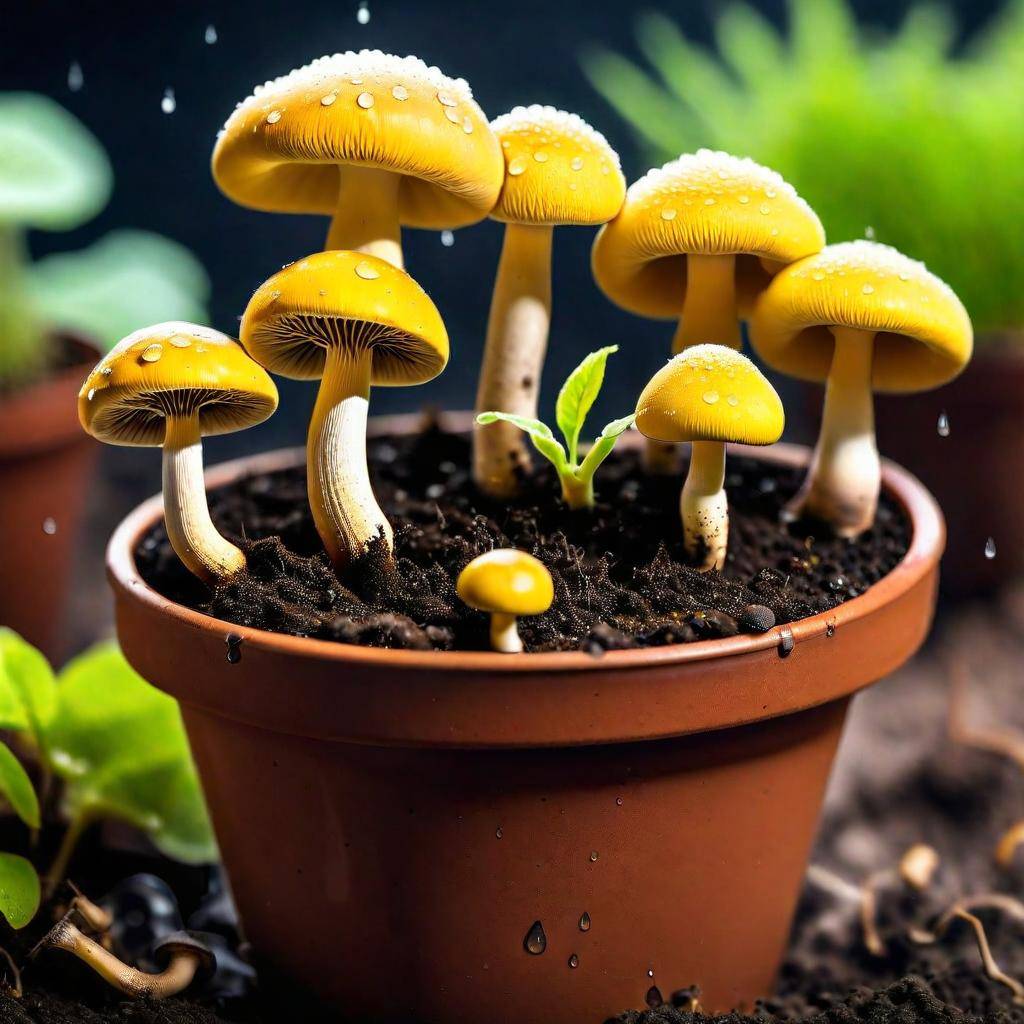
Are Yellow Mushrooms Harmful?
A typical question is whether these yellow mushroom in potted plant are dangerous to people or plants. Most of the time, the answer is no, but there are some exceptions:
To Plants
They break down dead organic matter instead of living plants, which is why yellow mushroom in potted plant are saprotrophic. In other words, they won’t hurt your plants. In fact, they can be helpful because they break down organic matter and add nutrition to the soil.
To Humans and Pets
Even though yellow mushroom in potted plant aren’t very dangerous, you shouldn’t eat them because they can make you or your pet sick. If you have dogs or kids who might be tempted to eat them, it’s best to get rid of them.
How to Prevent Yellow Mushroom in Potted Plant
When it comes to the management of yellow mushroom in potted plants, prevention is the most important factor. The following is a list of successful strategies:
1. Control Watering
Do not give your plants too much water. If you want to lower the amount of water that mushrooms need to grow, let the dirt dry out between waterings. Make sure the pots can drain well so that water doesn’t pool at the bottom.
2. Reduce Humidity
If you can, make the air around your plants less wet. Adding more air flow, using a dehumidifier, or moving plants to a less humid place are all ways to do this.
3. Use Sterile Potting Mix
Use clean potting mix when you move plants or put new ones. It’s less likely that sterile mixes will have biological matter that mushrooms can break down.
4. Remove Organic Debris
Remove dead plants, leaves, and other organic matter from the soil’s top on a regular basis. This takes away food sources for mushrooms.
How to Get Rid of Yellow Mushroom in Potted Plants
If yellow mushrooms have already shown up in your plants in pots, follow these steps to get rid of them:
1. Removal by hand
The easiest way is to take the mushrooms out by hand as soon as they show up. Peel them off with gloves, making sure to get the base as well, and throw them away in the trash. Make sure they don’t spread germs.
2. Change the Soil
If the mushrooms don’t go away, you might want to change the dirt. Take the plant out of the pot, shake off as much dirt as you can, and then put it back in a new pot with clean potting mix. This works, but it can be hard on the plant, so you should only use it as a last option.
3. Use Fungicides (With Caution)
Fungicides can be used to get rid of mushrooms, but they don’t always work on fungi that grow in dirt. If you do decide to use a pesticide, make sure it is safe for indoor plants and carefully follow the directions.
Mushroom in Houseplant: A Symbol of Good Luck?
A houseplant brings nature inside, and they’re not only nice to look at but also good for you in many ways. Among the many shocks that come with taking care of houseplants, finding mushrooms growing from the ground can be one of the most interesting. Some people might be scared of these plants, but others see them as a sign of good luck. This piece will talk about what mushrooms in houseplants mean, whether they bring good luck, and how to take care of them. It will also talk about how common it is for a yellow mushroom to show up in potted plants.
The Appearance of Mushrooms in Houseplants
There are more mushrooms in flowers than you might think. It’s common for these fungi to show up when the dirt is moist, there is organic matter in it, and the weather is just right. Most of the time, people see the Leucocoprinus birnbaumii (yellow mushroom in potted plants), which grows in the ground when it’s warm and damp.
Mushrooms as a Symbol of Good Luck
In many different countries, mushrooms have been seen as signs of luck, long life, and wealth. In some Asian cultures, mushrooms are thought to help people live forever, and they are often used as signs of health and happiness in art and legends. It’s possible that the sudden arrival of mushrooms, especially a yellow mushroom in potted plant, is a good sign that life is thriving in your home.
In the eyes of people who believe in mushroom meanings, seeing a yellow mushroom in your growing plant could mean that the plant is healthy and happy. The growth of these fungi could also be seen as a reminder to stay linked to nature and to your roots, which will bring harmony and balance into your home.
Are Mushrooms Harmful to Houseplants?
Even though mushrooms, like the yellow mushroom that grows on plants in pots, can be interesting to look at and even lucky, they don’t always hurt the plant. Actually, mushrooms are a natural part of the breakdown process. They break down organic matter in the soil and give plant nutrients back to it. Their appearance usually means that the soil is healthy and full of organic matter.
There are, however, ways to deal with yellow mushrooms if you don’t want them in your potted plant or if they seem to be growing too quickly. Taking the mushrooms off by hand and changing how often you water can help cut down on their number. Making sure there is enough air flow around your plants and not giving them too much water can also keep mushrooms from coming back.
Managing Mushrooms in Houseplants
Here are some things you can do if you decide you don’t want a yellow mushroom in your potted plant:
- Remove the Mushrooms: Take the mushrooms out of the ground carefully and throw them away. Make sure you don’t hurt the plant’s roots.
- Improve Soil Drainage: Since mushrooms like it when it’s damp, adding sand or perlite to the dirt to help it drain better can help keep them away.
- Adjust Watering Practices: Mushrooms often grow because they get too much water. Don’t water the top layer of dirt too often; this will stop fungi from growing.
- Increase Air Circulation: Making sure there is enough air flow around your plants will help keep the soil from getting too wet and stop mushrooms from growing
Embracing the Luck
If someone thinks that seeing a yellow mushroom in their plant pot is a sign of good luck, they don’t need to do anything rash. Instead, accept them as a normal part of the ecosystem in your indoor garden. Enjoy the unique and often surprising beauty that these fungi bring, and let them tell you that your plants and the environment should work together in harmony.
Understanding Yellow Fungus in Potted Plants
Finding yellow fungus on your potted plant can be scary, especially if you don’t know how it will affect the plant’s health. This yellow growth is often mistaken for mold or mushrooms and can show up in a number of indoor growing situations. If you have plants in pots, the yellow mushroom usually shows up as a powdery or slimy growth on the dirt, plant leaves, or stems. This fungus generally grows because of conditions in the environment that help fungi grow, like too much moisture, poor air flow, and high humidity.
Even though it might look scary, it’s important to find out if the fungus is really hurting your plant or just a problem on the surface. The following types of yellow fungi are often found on plants in pots:
- Powdery Mildew: A disease caused by fungi that shows up on the leaves, stems, and flowers as a white or yellowish powder.
- Fusarium: These are the kinds of fungi that can turn leaves yellow and make soil look yellow.
- Smut Fungi: These can cause growths that are yellow or black, mostly on plant parts and soil
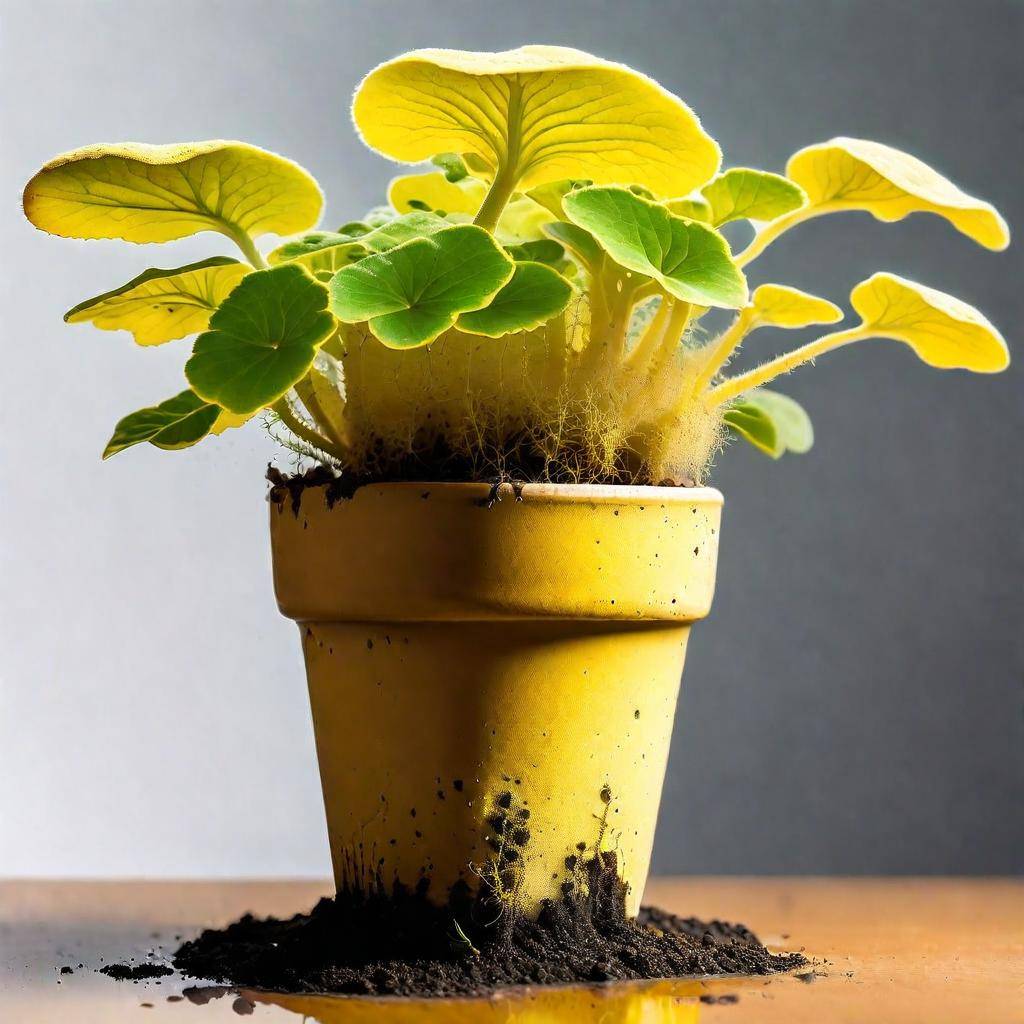
Causes of Yellow Fungus
There are several things that can cause yellow fungus to grow on plants in pots:
- Excessive Moisture: When dirt doesn’t drain well or gets too much water, it stays wet, which is good for fungi to grow. If you let water sit still, fungus will grow in wet places.
- High Humidity: It is possible for fungal spores to germinate and spread in an environment that is characterized by high humidity levels, particularly when the environment is the indoors.
- Poor Air Circulation: Fungal problems can get worse when air around the plant doesn’t move, which keeps the soil and plant surfaces from drying out.
- Organic Matter: It is possible for fungi to grow in places where dead plants or dirt that is too rich can provide food for the fungus.
Effects of Yellow Fungus on Plants
There are several ways that yellow fungi can hurt your plant in a pot:
- Reduced Plant Health: When yellow fungus in potted plant, like powdery mildew, grows on leaves and twigs, it can stop photosynthesis from happening. This can make plants grow and stay healthy less.
- Leaf Damage: If leaves get yellow fungi, they might curl, turn yellow, or fall off too soon, which would look bad and be bad for the plant’s health.
- Root Problems: Some fungus can get into the roots and cause root rot, which makes it hard for the plant to take in water and nutrients.
Managing Yellow Fungus in Potted Plants
To get rid of yellow fungus on your plants in pots, follow these steps:
- Adjust Watering Practices: Don’t give your pots too much water, and make sure they can drain well. You should only water your plants when the dirt on top feels dry.
- Improve Air Circulation: Spread your plants out evenly and use fans if you need to to improve the temperature around them. This lowers the humidity and helps the dirt and plant surfaces dry out faster.
- Reduce Humidity: If you are having trouble with high humidity, you could use a dryer or put a tray of water near a heat source to help lower the humidity.
- Remove Affected Parts: Cut back and get rid of any plagued leaves or plant parts. Throw away these plant parts in the right way to stop the spread of mold spores.
- Apply Fungicides: You might need to use a pesticide if the fungus doesn’t go away. Choose items that are safe for indoor plants and follow the directions on the package for how to use them.
- Repot with Fresh Soil: To get rid of fungal spores and improve plant health, repot your plant with new, clean potting soil if the yellow fungus in potted plant is widespread or stays around.
To keep yellow fungus from coming back, try these steps:
- Monitor Watering: Make sure you don’t water too much and that the soil can drain well. Plants only need water when they need it.
- Maintain Proper Humidity: Check the humidity level inside and make sure there is enough air flow around your plants.
- Regular Inspection: Check your plants often for signs of mold growth or other problems. Finding problems early on can help you handle them before they get worse.
- Use Well-Draining Soil: Do not use garden soil because it can hold too much water. Instead, use potting mixes that are made to drain well.
Common Myths About Yellow Mushroom in Potted Plants
There are a few myths about yellow mushrooms growing in plants in pots. Here are some of the most popular ones that aren’t true:
1. “Mushrooms are a sign of a sick plant.”
Not true. Having mushrooms on your plant does not mean it is sick. They are just saying that the soil has a lot of organic matter and water, which are great for mushrooms.
2. “Mushrooms are highly toxic and should be avoided at all costs.”
Not all the time. Yellow mushrooms are not safe to eat, but they are also not very dangerous. But they should still be taken off so that pets or kids don’t eat them by chance.
3. “Mushrooms will kill my plant.”
Not right. When mushrooms grow on plants in pots, they break down dead plant matter and don’t eat live plant tissue. The don’t live on plants and won’t hurt them.
Conclusion
It might be strange to see a yellow mushroom growing in a potted plant, but they are usually harmless and can even be a sign of a healthy, organic atmosphere. You can keep your plants healthy and keep mushrooms out of your home garden by learning what causes them and how to control them.
Seeing mushrooms on flowers can be both interesting and fun. Whether you think of them as a lucky charm or just a normal part of the plant’s environment, they are generally safe and can even mean that the soil is healthy and rich. If you know what they do and how to take care of them, you can choose whether to keep them in your home garden or get rid of them. The fact that mushrooms are growing in your houseplant makes it even more interesting and magical to garden indoors.
Yellow fungus in potted plant is not a nice sight, but knowing what causes it and how it spreads can help you get rid of it or keep it from happening. You can keep your indoor garden healthy and lessen the effects of yellow fungus by changing how you care for your plants and fixing problems in the surroundings. Regular care and attention will keep your plants healthy and full of life, free of any problems caused by fungi.
FAQ’S
Can I leave yellow mushrooms in my potted plants?
Yes, you can leave them if they don’t bother you. They won’t hurt your plants. But if you have kids or pets, it’s best to take them down.
How long do yellow mushrooms last in potted plants?
Yellow mushrooms can stay around for a few days to a week, based on where they are. They will break down on their own over time.
Will repotting my plant get rid of yellow mushrooms?
Putting the plants in new pots with clean soil can help get rid of yellow mushrooms, but they might come back if the conditions are still right for them to grow.
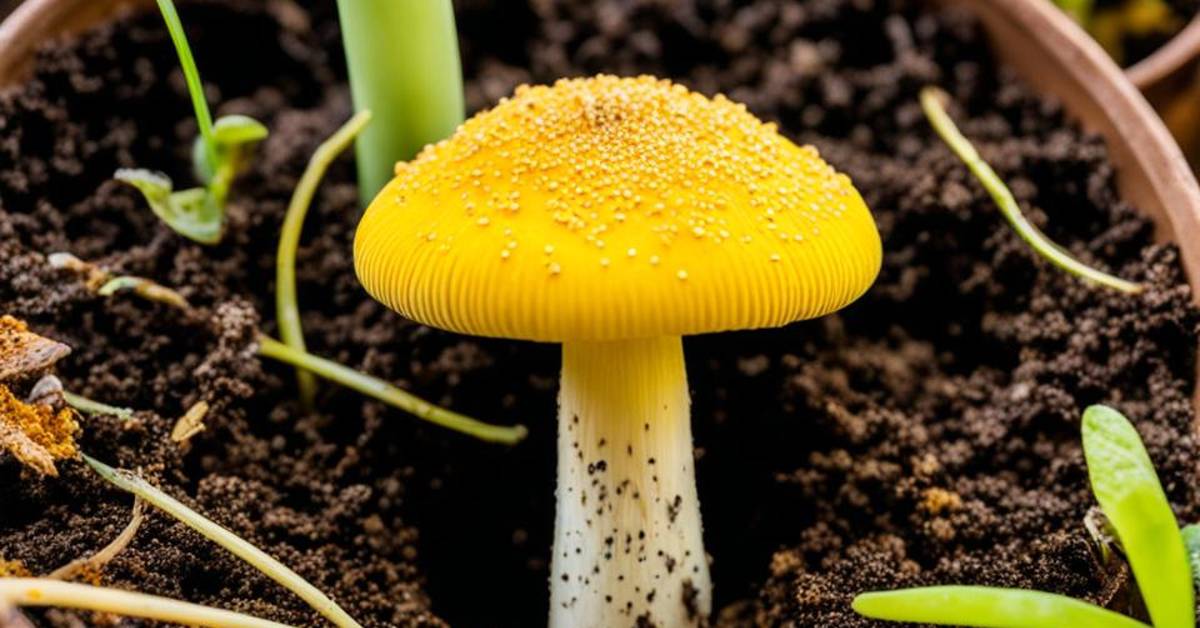
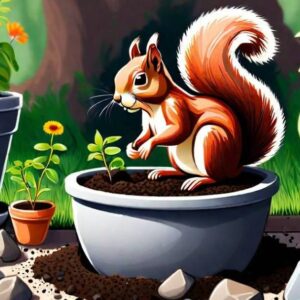
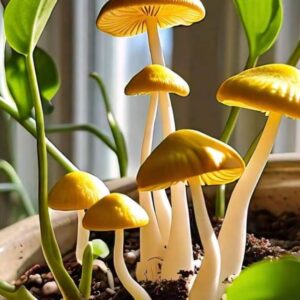

Pingback: How to Grow Grass in Sandy Soil: A Step-by-Step Guide
Pingback: Top Reasons wilting Tomato Plants in Pots : How to Fix It Fast
Your article helped me a lot, is there any more related content? Thanks!
Yes, I provided soon